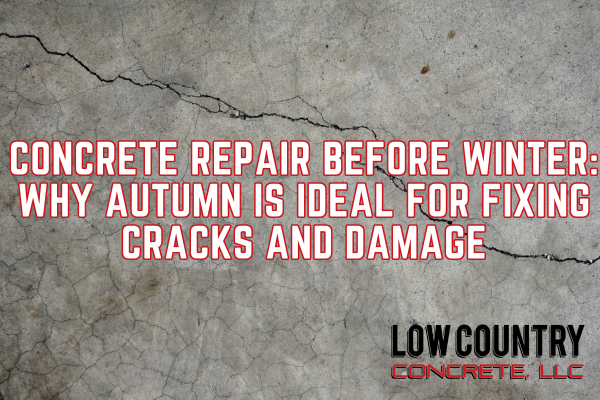As autumn settles over the Low Country of Georgia and the Carolinas, the vibrant foliage and cooler temperatures signal not just a change in seasons but also an ideal time for concrete maintenance.
For homeowners and property managers, autumn offers a crucial window to address concrete issues before the harsher conditions of winter set in. Repairing concrete before winter is essential for preventing further damage, ensuring safety, and preserving the longevity of your concrete surfaces. In this blog, we’ll explore why fall is the perfect time for concrete repairs and provide practical tips for tackling those essential maintenance tasks.
The Impact of Winter on Concrete
Winter in the Low Country can bring unpredictable weather, including freezing temperatures, ice, and occasional snow. Concrete is particularly vulnerable during this time. When cracks and damage are left unaddressed, winter conditions can exacerbate these issues in several ways:
- Freeze-Thaw Cycles: Water that seeps into cracks can freeze and expand when temperatures drop. This freeze-thaw cycle puts immense pressure on the concrete, worsening existing cracks and creating new ones.
- Ice Formation: Ice can form in cracks and crevices, causing further deterioration of the concrete surface. Additionally, ice can create hazardous conditions, increasing the risk of slips and falls.
- Salt and Chemicals: De-icing salts and chemicals used to manage ice can be corrosive to concrete. If your concrete is already damaged, these substances can accelerate deterioration, leading to more extensive and costly repairs.
By addressing concrete repairs in the fall, you can mitigate these risks and protect your investment in concrete surfaces.
Why Autumn is Ideal for Concrete Repairs
- Optimal Temperature Conditions
Autumn offers cooler but not freezing temperatures, which are ideal for concrete repairs. Concrete needs to be poured and cured in a temperature range that allows it to set properly. Too hot, and it can set too quickly; too cold, and it can freeze before it cures properly. Fall temperatures in the Low Country are typically mild and stable, providing the perfect conditions for concrete repair and curing.
- Dryer Weather
Fall generally brings drier weather compared to the spring and summer months. Excess moisture can interfere with concrete repairs, leading to issues such as improper curing or efflorescence (white, powdery deposits on the surface). With less rain and more stable weather, autumn is an excellent time to perform repairs and ensure a high-quality finish.
- Preparation for Winter
Repairing concrete in the fall ensures that your surfaces are in good condition before winter arrives. This proactive approach prevents small issues from becoming major problems as winter weather exacerbates existing damage. By taking care of repairs now, you can avoid the inconvenience and potential safety hazards associated with deteriorating concrete during the winter months.
Low Country Concrete Is Here To Help
We can help you assess damage, recommend repairs, and schedule a crew to take action before the seasons change. Here’s how Low Country Concrete acts as your partner in the process:
- Inspect for Cracks and Damage
We’ll start by thoroughly inspecting your concrete surfaces for cracks, spalling, or other damage. Common areas to check include driveways, sidewalks, patios, and foundation walls. Our contractors will assess the extent of the damage to determine the appropriate repair method.
- Clean and Prepare the Surface
Proper surface preparation is crucial for effective repairs. We’ll clean the concrete surface thoroughly, removing any dirt, leaves, or algae. For larger cracks, we may need to use a chisel and hammer to remove any loose material and widen the crack slightly to allow the repair material to adhere properly. Trust the process!
- Choose the Right Repair Materials
Our experts will select repair materials that are suitable for the type and extent of the damage. For small cracks, a concrete crack filler or epoxy resin may be sufficient. For more extensive damage, you might need a concrete patching compound or resurfacer. We’ll ensure that the products you choose are designed for use in cooler temperatures and have a suitable curing time for fall conditions.
- Apply the Repair Materials
Your Low Country Concrete team will mix and apply the repair materials. Typically, this involves filling the cracks or damaged areas with the chosen product, smoothing it out, and allowing it to cure properly. We’ll watch the forecast to avoid applying repair materials during extremely cold or damp conditions, as this can affect the curing process.
- Seal the Concrete
Once the repairs are complete and fully cured, our team can recommend a concrete sealer to protect the surface from moisture and other environmental factors. A high-quality sealer can help prevent water penetration and reduce the impact of freeze-thaw cycles during winter.
As Seasons Change, Low Country Concrete Will Help You Protect Your Investment
Autumn provides an optimal window for addressing concrete repairs before winter’s harsher conditions take hold. By taking advantage of the mild temperatures and drier weather, we can ensure that your concrete surfaces are well-maintained and protected against the challenges of winter. Don’t wait until winter’s chill sets in—schedule your concrete repairs this fall to safeguard your investment and enjoy a safer, more durable concrete surface throughout the year.


Recent Comments